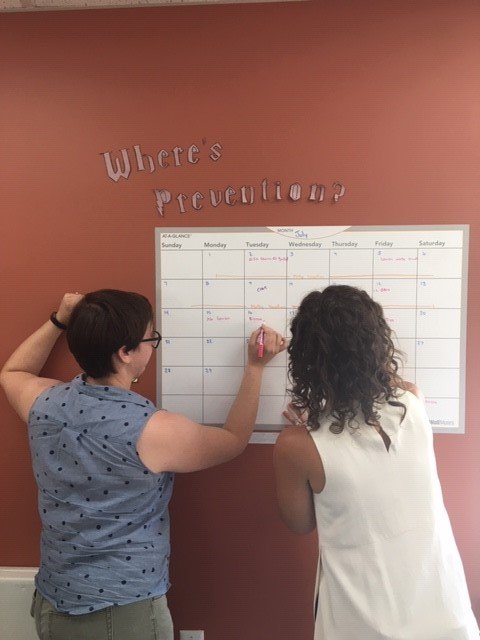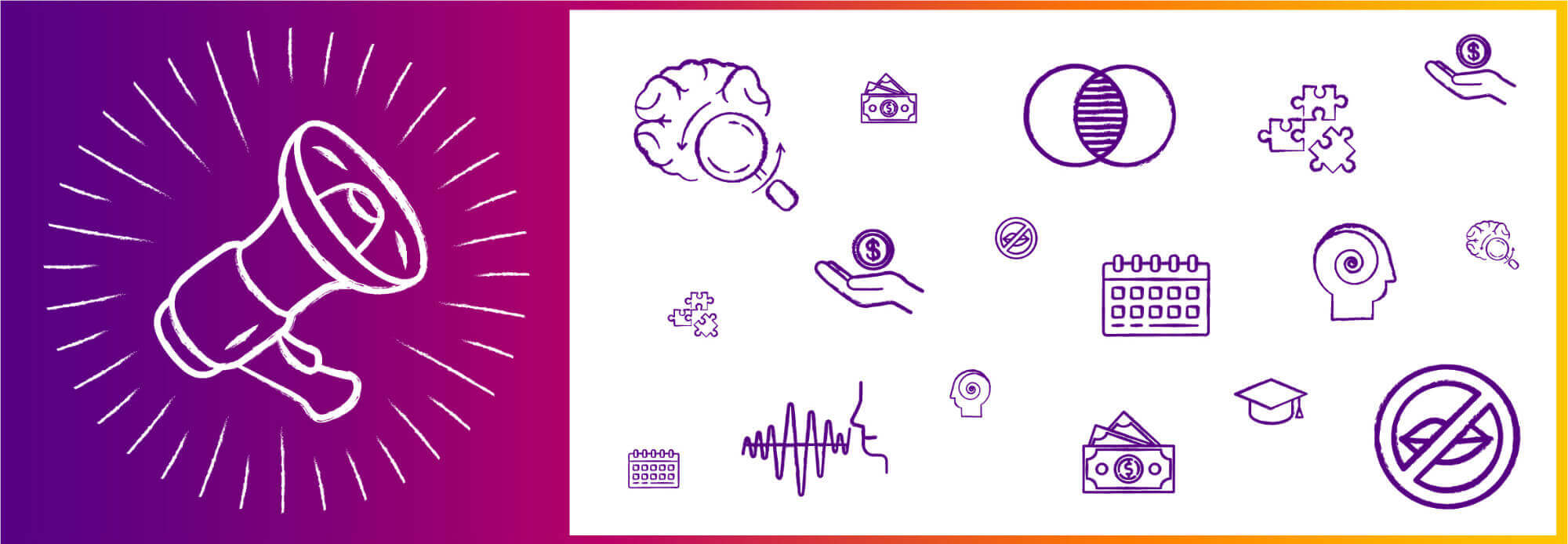
If you visit REACH’s new office and you happen to walk by the Prevention office, you will see a large calendar posted on the wall with the question, “Where is Prevention?” written in Harry Potter-esque lettering above. At a Prevention team retreat last summer, I had joked that we needed the Whereabouts Clock described in the Harry Potter books to keep track of the whereabouts of the members of the Weasley Family. If you were to study the Prevention calendar, you would see the names of schools, faith organizations, businesses, community organizations, and more. You might wonder why certain places are listed, why some are listed on several dates and others just once, and what we might be doing in all of these places and spaces. Each member of the Prevention team has a color assigned to them: orange for Molly, our Youth Education Specialist, pink for Lauren, our Community Engagement Specialist, and purple for me, the Director of Prevention Programs. From time to time we have replicated this colorful display on our website with a News Item entitled, “Where is REACH’s Prevention Team?” Today we are sharing with you where is Prevention GOING and WHY. We are adding a new color- a Volunteer Program Coordinator- to our amazing team, and we are so excited to share with you why we are adding this new position, and where this expansion will take us.
Last year, REACH completed a strategic planning process to take us through 2021. In this process we identified five priority areas and we worked in committees of staff and board to focus on each of the areas and identify goals and strategies. I chaired a committee focused on “Deepening and Expanding Prevention and Community Engagement.” The title, in addition to being wordy, illustrates a tension we often hold in prevention work. We want to be expansive in our reach throughout the 27 cities and towns we serve, and we also want to deepen the work we are doing in and with communities. This is a tension that many domestic and sexual violence organizations have grappled with for a long time.
For many years, funding for domestic violence and sexual assault prevention was awarded to programs that reached the greatest number of participants. With all good intentions, supporters tried to ensure that as many individuals as possible, particularly young people, had some knowledge about this issue and the resources available to them. But going to so many classrooms and group spaces meant that prevention professionals would rarely return to the same group more than once. This “sprinkling” approach – giving a small amount of information to a large number of participants – is like watering a lawn without providing fertilizer. While it might pique listeners’ curiosity, it does not allow the ideas to take root.
This is not to say that sprinkling information about domestic violence prevention has no value. On the contrary. Domestic violence thrives in silence, so the more conversations we can start and the more awareness we can engender, the better. REACH Beyond Domestic Violence has spent more than a decade bringing understanding of domestic violence to 27 Greater Boston cities and towns. We have spread the word far and wide about what domestic violence really is and what it may look like, and how to respond to its reality in our communities.
Valuable as it is, the down side of the sprinkling approach is that, in most cases, the knowledge sits on the surface of people’s awareness where it is easily shaken loose by other needs and priorities. More concerning is that, for some, these quick introductions can trigger deep thoughts and recollections of pain that they have no way to process in the moment. They need deeper knowledge and understanding in order to work through the issues for themselves or become effective allies for others. Sustainable change to the conditions that contribute to violence requires saturating the environment with information, ideas, responses, and understanding.
Making lasting change is the “teach someone to fish” model, but in this case, it is not only individuals learning to fend for themselves, it is entire communities understanding how to face down the specter of domestic violence in their midst, and having the skills to do so. Real prevention and social change happen when we are able to partner with community members in a way that builds their own capacity to recognize, respond to, and prevent domestic violence.
We know the work to support healthy relationships is sustainable when it becomes part of the culture of a community, not tied to one individual’s knowledge, whether that person is a teacher, preacher, political leader, or any other single person. Saturation means that if the influencer leaves, the work goes on through others whom they have trained and the structures that have been developed. The community, not REACH, needs to own the knowledge, motivation, and desire to change the culture from one that implicitly and explicitly condones domestic violence to one that condemns it. Ownership means that communities have intrinsic motivation to take on the work, not because it’s what REACH says they should do, but because it is what they believe in and what they want to do.
REACH’s long-term goal is nothing less than changing the culture around domestic violence. Doing so involves creating deeper relationships that enable longer and more serious conversations, and ongoing training and edification. We want schools and communities to do more than check off “We brought REACH in for a workshop this year,” as though that is the sum total of their responsibility and the end of their engagement. Changing the culture is an intentional, extensive process that requires cultivating many points of contact such as teachers, wellness directors, principals, coaches, religious leaders, etc. Finding these allies and ensuring their understanding and cooperation takes time and resources.
As we engaged in this strategic planning process, we tried to think of strategies that would allow us to reach many people throughout our service area and deepen our work in a few selected communities. Several of us began to think aloud about the role volunteers can and have played in our organization.
REACH was founded by a group of volunteers who wanted to educate their community about domestic violence. From our earliest days as an organization, we knew that we needed to partner with our communities to get at the root of the problem and achieve our goal of eliminating domestic violence. We have an opportunity to utilize our volunteers to shift from a responsive paradigm to a proactive one. A responsive approach helps educate communities that the problem exists; a proactive approach empowers a community to eliminate the problem altogether.
We know that leading this kind of change is a several-year, several-step process. It takes resources and people power. We identified in our strategic plan the need to add a Volunteer Program Coordinator to help us build a cadre of volunteer educators to provide a basic level of instruction throughout our 27-city catchment. This person will work with the Prevention team to develop train-the-trainer modules consisting of both DV-related content and learning and practicing facilitation skills. The work that the volunteer educators will take on will allow our current prevention staff to have the time they need to develop and strengthen relationships in select communities and conduct in-depth education, programming, and policy work. With a new team member in place, we can both sprinkle and saturate – spread awareness about the abomination of domestic violence while inculcating deep knowledge and tactics in certain places. Last month we learned that Jane’s Trust had accepted our proposal to support the work of our prevention team and to add a Volunteer Program Coordinator to make this strategy possible. We are so grateful for partners like Jane’s Trust that are truly committed to finding solutions to end domestic violence in our communities.
Please join us in our excitement as we look for a wonderful new team member to help us realize our vision: safe and healthy relationships for individuals and communities. For more information about this new position and to apply, please visit our website.





